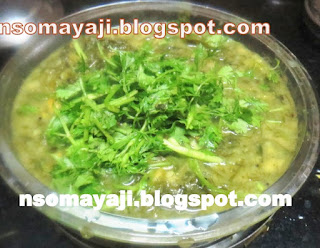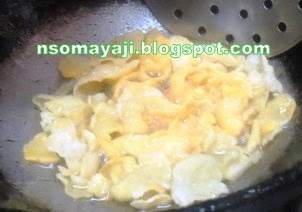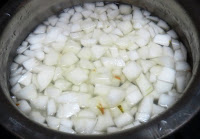Mixed Leaves spicy Dal is one of the side dish that goes well with almost all the main dishes. It is prepared using 2 to 3 or more types of leaves and dals, like toor/moong/masoor/chana etc.
I have used the leaves which we got from our home garden (grown in pots) and toor dal. I have added green tamarind chutney/tokku which I got from Dharwad. ( Our daughter in law Vidya's Home town).
Tamarind chutney/tokku is home prepared, using unripe tamarind, green chilly, roasted methi seeds and salt. Tokku taste so yummy and it goes well with hot rice and ghee, or adding to any dal preparation even I have tried Tamarind Tokku vegetable rice.
Let us see some benefits of eating tamarind in our diet.
Tamarind helps to reduce inflammation in our body. It helps to improve eye health, boost respiratory health and helps to heal skin conditions. It is good for digestive system. It relieve pains and strengthen our immune system. It helps to lower the cholesterol and good for kids since it fight against the worms in kids stomach. Tamarind is rich source of dietary fiber. It helps in easing constipation problems. It is rich in Vitamin C, Vitamin E, Vitamin B, Calcium, Iron, Phosphorous, Potassium, Manganese. It is rich in antioxidants and anti inflammatory properties.
As I said I have used our home grown Palk, Dil Leaves and very little basale /Malabar Leaves.
No Onion OR No Garlic is used in this " Mixed Leaves Spicy Dal".
Let us see the recipe Now :
Ingredients :
To Cook :
Dil Leaves : 1 Small Bundle
Palak : 1 Small Bundle
Malabar Leaves/Basale Leaves : One Handful
Toor Dal : 1/Cup
To Add :
Dry ginger powder : 1/2 Teaspoon
Tamarind Chutney /Tokku : 1 Teaspoon
Crushed pepper pods : 4 to 5
Salt : As Required
Coriander leaves : 2 Tablespoons
Butter/Ghee : 1 Teaspoon (Optional).
To Season :
Cooking Oil : 1 Teaspoon
Mustard Seeds : 1 Teaspoon
Jeera : 1/2 Teaspoon
Green chilly : 2 to 3
Curry Leaves : 6 to 8 or little more
Ingh/Asafoetida : A little
Method :
1. Clean and Wash all the leaves nicely and cut into small pieces.
2. Pressure cook it for 6 to 8 minutes.
3. Wash dal and pressure cook separately.
4. Wash and slit green chilly and cut coriander leaves.
5. Keep a big pan and put cooked leaves and dal together.
6. Add turmeric powder and salt.
7. Add dry ginger powder and pepper pods.
8. Add tamarind chutney/tokku. Stir slowly and mix it well. Let it boil for 2 to 3 minutes.
9. Keep a pan and prepared mustard, jeera seasoning. Add slit green chilly and fry it nicely.
10. Add ingh and curry leaves to seasoning and add this seasoning to Mixed Leaves Spicy Dal.
11. Boil it for another 3 to 4 minutes. Shift it to the serving bowl.
12. Serve with your choice of main dish.
Note :
Cooking leaves in pressure cooker helps them to be soft. It can be cooked without using pressure cooker. (Optional). Use of onions and garlic is optional. ( I have not used). You can use tamarind pulp instead of tamarind chutney/tokku. Taste differs. Adding a teaspoon of butter/ghee to Mixed Spicy Dal taste better. (Optional). Use of more/less chilly is optional.
Time : 30 Minutes.
Serves : 3 to 4.


















































